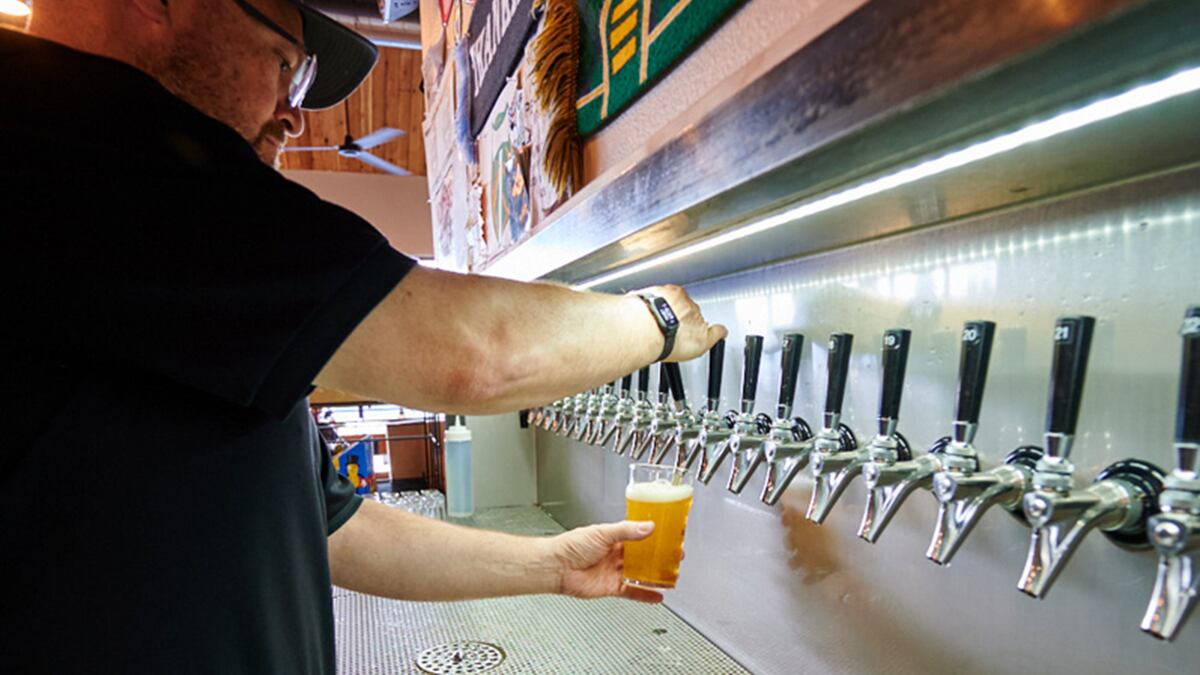Glass is out, metal is in.
People are no longer swigging out of long-neck glass bottles. Cans keep your IPA from skunking, don’t require bottle openers, take up less room in the fridge, and fit into the pocket of a hoodie. The only drawback is that it’s a lot harder to make a Molotov cocktail out of an aluminum container, should you need one.
Growlers are out, 19.2-ounce cans are in.
Oregon is filled with growler stations that years ago popped up in every strip mall for the primary purpose of filling moldy-ass, half-gallon brown jugs with beer that will inevitably go flat in two days. Thanks to mobile canners, giant stove pipe-style 19.2-ounce cans are now the best way to take home your beer.
Sexualized labels are out, socially conscious art is in.
Before the Trump administration, beer labels used to feature more sexual innuendo and sleazy misogynistic jokes about stacked blond (ales) and easy redheads than an entire season of The Apprentice. Now, packaging naming and art tends to be split between jokes about the former president (covfefe, tiny hands, stable genius) and messages championing causes like the Black Lives Matter movement, wildfire relief and women’s rights.
Beer bars are out, satellite taprooms are in.
In Oregon, you can find a good beer list at a white tablecloth restaurant or your neighborhood strip club. But people love to go to the source, so breweries realized that instead of fighting for tap handles or grocery store shelf space, they should go directly to consumers by opening multiple branded taprooms, cutting out distributors and the potentially fickle independent bar buyer. Unfortunately, non-brewery-affiliated taprooms that kept the industry afloat for so long will be the first casualties.
Brewpubs are out, food trucks and catering partners are in.
Instead of having customers struggle with Wi-Fi and QR codes to download an uncompressed PDF file of a limited menu prepared by a short-staffed kitchen, breweries and taprooms are now relying on food carts and catering companies to provide just enough hot dishes to get the state liquor commission to allow kids minors inside their bare-bones tasting rooms.
Seltzer is out, N/A beer is in.
Hard seltzer was fueled by spring breaks and a 20-something crowd of woo girls and bruhs looking for a quick buzz without having to learn the difference between IPA and gose. Realizing they were losing the prized young-drinker demographic, craft breweries flocked to hard seltzer like white girls to a Taylor Swift concert. But the luster faded as fast as a spray-on tan as they realized the non-alcoholic beer market was pretty much up for grabs, which has no side effects!
Smoothie sours are out, cask beer is in.
Before the infantilization of alcohol in recent decades, our great-grandfathers were quaffing warm pints of dark mild ale from a cask engine at the local tavern. Now kids are TikToking about smoothie sours that are so packed with fruit puree and artificial ingredients that they explode unless kept at the coldest temperatures. Beer nerds who’ve grown tired of cleaning up shrapnel from $10 cans of blueberry doughnut slushie sour are now turning to cask ale. The beer relies only on malt, hops and gentle carbonation from natural refermentation in the keg before it’s then served at a warmer temperature that won’t mask flaws.
Lining up for rare releases is out, signing up for exclusive beer membership clubs is in.
Beer nerds used to line up around the block for dock sales of limited-release hype beers from their favorite brewery and then check them off their street cred list. With the dawn of black market forums for beer resale, and breweries creating exclusive, subscription-only memberships, beer connoisseurs have abandoned their sidewalk pop-up camps, but they’re still logging beers into a mobile app to earn merit badges like a prepubescent Boy Scout.
Imported beer is out, making it distinctly American is in.
Beer snobs used to seek out imported abbey ales brewed by Trappist monks. Now they are all about Pilsners locally made with heirloom hops from Yakima, Wash., and fermented with a wild yeast cultivated from the beard of a well-coiffed hipster in a faded YOB T-shirt.

